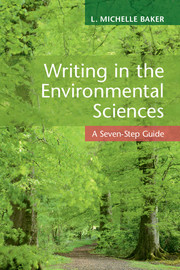References
Alley, Michael. (2013). The Craft of Scientific Writing, Springer.
Bentley, Peter and Kyvik, Svein. (2011). Academic staff and public communication: a survey of popular science publishing across 13 countries, Public Understanding of Science, 20(1), 48–63, DOI: 10.1177/0963662510384461
Berman, Bob. (2015). Send astronauts to Zappafrank, Strange Universe, Astronomy, 43(7), 11.
Bucchi, Massimiano and Trench, Brian, eds. (2014). Routledge Handbook of Public Communication of Science and Technology, 2nd edn, Routledge.
Burton, Kimberly D.; Lydon, John E.; D’Alessandro, David U.; and Koestner, Richard. (2006). The differential effects of intrinsic and identified motivation on well-being and performance: Prospective, experimental, and implicit approaches to self-determination theory, Journal of Personality and Social Psychology, 91(4), 750–762. DOI: 10.1037/0022–3514.91.4.750
Cargill, Margaret and O’Connor, Patrick. (2009). Writing Scientific Research Articles, Wiley-Blackwell.
Carson, Rachel. (1962). Silent Spring, Houghton Mifflin Company.
Churchill, Winston. (2003). Never Give In! The Best of Winston Churchill’s Speeches, Selected by Churchill, Winston S., Hyperion.
Day, Robert A. and Gastel, Barbara. (2006). How to Write and Publish a Scientific Paper, 6th edn, Cambridge University Press.
Deci, Edward L. and Ryan, Richard M.. (2008). Facilitating optimal motivation and psychological well-being across life’s domains, Canadian Psychology, 49(1), 14–23, DOI: 10.1037/0708–5591.49.1.14
Einsiedel, E. F. and Thorne, B.. (1999). Public responses to uncertainty. Friedman, S. M., Dunwoody, S., and Rogers, C. L., eds., Communicating Uncertainty: Media Coverage of New and Controversial Science, Lawrence Erlbaum, pp. 43–58.
Government Printing Office. (2008). Style Manual: An Official Guide to the Form and Style of Federal Government Printing, United States Government Printing Office.
Gregory, Jane and Miller, Steve. (1998). Science in Public: Communication, Culture, and Credibility, Perseus Publishing.
Harmon, Joseph E. and Gross, Alan G.. (2010). The Craft of Scientific Communication, University of Chicago Press.
Hedrick, Philip W. (1995). Panther as a case study, Conservation Biology, 9(5), 996–1007.
Hofmann, Angelika. (2010). Scientific Writing and Communication: Papers, Proposals, and Presentations, Oxford University Press.
IUCN (International Union for the Conservation of Nature). (2007). Grouse: Status Survey and Conservation Action Plan 2006–2010, Compiled and edited by Ilse Storch, IUCN and World Pheasant Association. 114 pp. https://portals.iucn.org/library/node/9145 Katz, Michael Jay. (2009). From Research to Manuscript, 2nd edn, Springer.
Lepper, Mark; Corpus, Jennifer Henderlong; and Iyengar, Shenna S.. (2005). Intrinsic and extrinsic motivational orientations in the classroom: age differences and academic correlates, Journal of Educational Psychology, 97(2), 184–196. DOI: 10.1037/0022–0663.97.2.184
Logan, Robert A. (2001). Science mass communication: Its conceptual history, Science Communication, 23(2), 135–163.
Lohmann, K.J.; Hester, J.T.; and Lohmann, C.M.F.. (1999). Long-distance navigation in sea turtles. Ethology Ecology and Evolution, 11, 1–23.
Marcinkowski, Frank; Kohring, Matthias; Fürst, Silke; and Friedrichsmeier, Andres. (2014). Organizational influence on scientists’ efforts to go public: an empirical investigation, Science Communication, 36(1), 56–80. DOI: 10.1177/1075547013494022
Matthews, Janice R. and Matthews, Robert W.. (2008). Successful Scientific Writing: A Step-by-Step Guide for the Biological and Medical Sciences, 3rd edn, Cambridge University Press.
Montgomery, Scott L. (2003). The Chicago Guide to Communicating Science, Chicago University Press.
Pearson, Carol. (2013) The Hero Within: Six Archetypes We Live By, Harper Collins.
Sansone, Carol and Harackiewicz, Judith M., eds. (2000). Intrinsic and Extrinsic Motivation: The Search for Optimal Motivation and Performance, Academic Press.
Schimel, Joshua. (2012). Writing Science: How to Write Papers that Get Cited and Proposals that Get Funded, Oxford University Press.
Shanahan, Marie-Claire. (2011). Science blogs as boundary layers: Creating and understanding new writer and reader interactions through science blogging, Journalism, 12(7), 903–919, DOI: 10.1177/1464884911412844
Spier, Ray. (2002). The history of the peer-review process, Trends in Biotechnology, 20(8), 357–358.
Springer, Sally P. and Deutsch, Georg. (1997). Left Brain Right Brain: Perspectives from Cognitive Neuroscience, 5th edn, W. H. Freeman and Company.
United States Department of Commerce, National Oceanic and Atmospheric Administration. (1999). Endangered and Threatened Wildlife and Plants; Definition of “Harm.” 50 CFR Part 222, Federal Register 64(215), 60727–60731.
United States Department of Labor, Bureau of Labor Statistics. (2015). May 2014 National Occupational Employment and Wage Estimates: United States, Overview of BLS Wage Data by Area and Occupation, www.bls.gov/oes/current/oes_nat.htm USFWS. (1994). Shenandoah salamander (Plethodon shenandoah) Recovery Plan, USFWS.
USFWS. (2014). Background: Species Information. Endangered and Threatened Wildlife and Plants: Western Distinct Population Segment of the Yellow-billed Cuckoo (Coccyzus americanus), Determination, FWS-R8-ES-2013-0104-0215, 50 CFR Part 17, FR 2014–23640. www.regulations.gov/document?D=FWS-R8-ES-2013-0104-0215 USFWS. Headquarters Office, Endangered Species Program. (2012). 12-month finding on petitions to list the Mexican Gray Wolf as an endangered subspecies or distinct population segment with critical habitat, Federal Register, 77(195), 61375–61377.
University of Maryland, University Libraries, Teaching and Learning Services. (2015). Style Manuals by Subject Discipline, www.lib.umd.edu/tl Weatherspoon, C. Phillip; Iwamoto, Y. Robert; and Piirto, Douglas D.; technical coordinators. (1986). Proceedings of the Workshop on Management of Giant Sequoia; May 24–25, 1985; Reedley, California. Gen. Tech. Rep. PSW-GTR-95. US Department of Agriculture, Forest Service, Pacific Southwest Forest and Range Experiment Station: 47 pp. www.fs.fed.us/psw/publications/documents/psw_gtr095/psw_gtr095_harvey.pdf Woodford, F. Peter. (1999). How to Teach Scientific Communication, Goode, Maureen E. and Gastel, Barbara, collaborators, Council of Biology Editors.
Zhang, Xioameng and Bartol, Kathryn. (2010). Linking empowering leadership and employee creativity: The influence of psychological empowerment, intrinsic motivation, and creative process management, Academy of Management Journal, 53(1), 107–128, DOI: 10.5465/AMJ.2010.48037118


 Loading metrics...
Loading metrics...